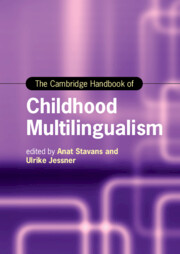Book contents
- The Cambridge Handbook of Childhood Multilingualism
- Cambridge Handbooks in Language and Linguistics
- The Cambridge Handbook of Childhood Multilingualism
- Copyright page
- Contents
- Figures
- Tables
- About the Editors
- Contributors
- Acknowledgments
- Multilingualism Is Not Bilingualism +1: An Introduction
- Part One Becoming and Being a Multilingual Child
- Part Two Cognition and Faculties in Multilinguals
- Part Three Family Language Policy
- Part Four Language(s) and Literacy of Multilingual Children through Schooling
- 15 Being Plurilingual in the Language Classroom
- 16 Literacy Development in the Multilingual Child: From Speaking to Writing
- 17 Attitudes, Motivations, and Enjoyment of Reading in Multiple Languages
- 18 Growing Up with Multilingual Literacies and Implications for Spelling
- 19 Assessing Multilinguals
- 20 Plurilingualism and Young Children’s Perspectival Cognition
- Part Five Socialization in Childhood Multilingualism
- Part Six Multilingual Children’s Landscape
- Subject Index
- Country Index
- Language Index
- References
16 - Literacy Development in the Multilingual Child: From Speaking to Writing
from Part Four - Language(s) and Literacy of Multilingual Children through Schooling
Published online by Cambridge University Press: 18 August 2022
- The Cambridge Handbook of Childhood Multilingualism
- Cambridge Handbooks in Language and Linguistics
- The Cambridge Handbook of Childhood Multilingualism
- Copyright page
- Contents
- Figures
- Tables
- About the Editors
- Contributors
- Acknowledgments
- Multilingualism Is Not Bilingualism +1: An Introduction
- Part One Becoming and Being a Multilingual Child
- Part Two Cognition and Faculties in Multilinguals
- Part Three Family Language Policy
- Part Four Language(s) and Literacy of Multilingual Children through Schooling
- 15 Being Plurilingual in the Language Classroom
- 16 Literacy Development in the Multilingual Child: From Speaking to Writing
- 17 Attitudes, Motivations, and Enjoyment of Reading in Multiple Languages
- 18 Growing Up with Multilingual Literacies and Implications for Spelling
- 19 Assessing Multilinguals
- 20 Plurilingualism and Young Children’s Perspectival Cognition
- Part Five Socialization in Childhood Multilingualism
- Part Six Multilingual Children’s Landscape
- Subject Index
- Country Index
- Language Index
- References
Summary
The chapter begins with a review of foundational studies on how monolingual children develop emergent literacy, then moves to explore how children develop multiliteracy by learning to interpret symbols and icons in their immediate contexts. The research shows that children find ways to experience and construct meaning from their local scripts in each of their multiple languages. Studies presented in this chapter show that children can interpret symbols in several different scripts, and that they find strategies to navigate multiple languages and become competent speakers in their communities.
- Type
- Chapter
- Information
- The Cambridge Handbook of Childhood Multilingualism , pp. 376 - 392Publisher: Cambridge University PressPrint publication year: 2022



